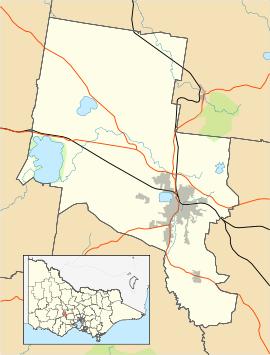Buninyong
| Buninyong Victoria | |||||||||||||
|---|---|---|---|---|---|---|---|---|---|---|---|---|---|
|
Main Street, Buninyong | |||||||||||||
 Buninyong | |||||||||||||
| Coordinates | 37°39′01″S 143°53′02″E / 37.65028°S 143.88389°ECoordinates: 37°39′01″S 143°53′02″E / 37.65028°S 143.88389°E | ||||||||||||
| Population | 3,244 (2011 census)[1] | ||||||||||||
| Postcode(s) | 3357 | ||||||||||||
| Location | |||||||||||||
| LGA(s) | |||||||||||||
| State electorate(s) | Buninyong | ||||||||||||
| Federal Division(s) | Ballarat | ||||||||||||
| |||||||||||||
Buninyong is a town 11km from Ballarat in Victoria, Australia.[2] The town is on the Midland Highway, south of Ballarat on the road to Geelong. It is the site of the first inland town proclaimed in Victoria and was where gold was first discovered in the area, leading to the large Gold Rush of the 1850s. The population at the 2011 census was 3,244.[1]
The name originates from an Aboriginal word also recorded as 'Buninyouang', said to mean 'man lying on his back with his knees raised', which is in reference to the shape of Mount Buninyong.[3] European settlers named it Bunnenyong[4] and the name later simplified to its current form.
History
Buninyong has an important place in history as the major inland community of pre-gold rush Victoria. It was explored in 1837 by the Learmonth Brothers - Thomas and Somerville - and others, and then subsequently settled in 1839 as a pastoral settlement.
A Post Office opened on 1 January 1845 to serve the needs of the settlers and was known as Bunnenyong until 1859.[5]
Although gold was being found in the area from about 1840 the 'official' finding of gold was when it was found 3 kilometres west of the town in 1851 by Thomas Hiscock, the local Buninyong blacksmith, at an area still known as Hiscock's.[6] Evidence is slowly emerging that the early pastoralists were finding gold, but not making their good fortune known because of the fear the Colonial Government would confiscate their finds because the whole area was Crown Land. By 1871 there were 2281 people and 20 hotels at Buninyong.
A significant figure in Buninyong's gold rush era was Henry Joseph Desoza.[7] Desoza was a wealthy philanthropist who made his fortune by both speculation and the leasing of both land and machinery to gold mining companies. One such enterprise was named the Desoza Freehold, from which Desoza received royalties. Desoza himself never held shares in The Desoza Freehold or any other mine he helped finance relying instead on the royalty system. In a peculiar ceremony in 1883 he was crowned with a circlet of gold mined from The Desoza Freehold. Thereafter Desoza was known as The Gold King of Buninyong. The Gold King title was celebrated in the township with a Gold King Festival held in February each year from 1975 to 2009.[8]
The town's wide streets were planned in expectation of further growth, however prosperity ended with the gold rush and the town reverted to a small pastoral settlement.
A railway from Ballarat was opened in 1889 with the passenger station completed in 1890, although it is no longer used. The line ran from the Ballarat railway station stopping at Ballarat East Station, Eureka Station, Levy Siding, Canadian Station, Mount Clear Station, Reid Siding, Mt Helen Siding terminating at the Buninyong Station. Popularly named 'The Bunny' the line ceased to carry passengers in the late 1930s, and freight in 1947 when the line was closed.[9][10]
Buninyong's landmarks include Mount Buninyong (volcanic mountain), gardens and the many historic buildings, including the Town Hall, Crown Hotel, Holy Trinity Church among others.
The Buninyong Botanic Gardens at Buninyong are among the oldest Botanic Gardens in the State of Victoria.
Today
There are several grand "boom style" homes in and around the town.
The town has an Australian Rules football team competing in the Central Highlands Football League.[11]
Golfers play at the Buninyong Golf Club on Learmonth Street.[12]
Notable residents
- O'Donnell, Thomas Joseph (1876–1949) Catholic priest[13]
References
- 1 2 Australian Bureau of Statistics (31 October 2012). "Buninyong (State Sunburb)". 2011 Census QuickStats. Retrieved 9 December 2014.
- ↑ http://www.buninyong.vic.au/
- ↑ UBD Victoria Country Road Atlas, 14th edition, Universal Publishers, 2004.
- ↑ http://gazette.slv.vic.gov.au/images/1848/P/general/41.pdf
- ↑ Premier Postal History, Post Office List, retrieved 11 April 2008
- ↑ Griffiths Peter M, Three Times Blest A History of Buninyong 1837 - 1901, Ballarat Historical Society pp13
- ↑ Henry Joseph Desoza from a paper presented to the Buninyong Historical Society by Robert W. Bell. Historian.
- ↑ "Archived copy". Archived from the original on 26 February 2011. Retrieved 2010-12-01.
- ↑ Australian Railway Historical Society Bulletin, July 1983, pp145-160
- ↑ Sid Brown (March 1990), "Tracks Across the State", Newsrail, Australian Railway Historical Society (Victorian Division), pp. 71–76
- ↑ Full Points Footy, Buninyong, archived from the original on 24 July 2008, retrieved 25 July 2008
- ↑ Golf Select, Buninyong, retrieved 11 May 2009
- ↑ "Australian Dictionary of Biography". adb.anu.edu.au. Retrieved 2015-08-03.
External links
![]() Media related to Buninyong, Victoria at Wikimedia Commons
Media related to Buninyong, Victoria at Wikimedia Commons
- A village with history, Sandy Guy, The Sydney Morning Herald, 21 February 2009.